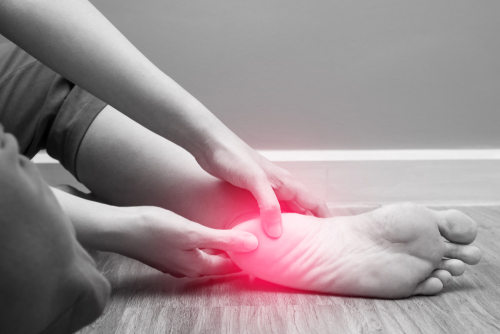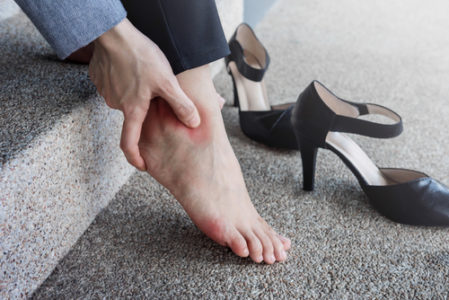
Plantar Fasciitis: Causes and At-Home Treatments
Categories: Exercises / Pain Management / Sports Medicine
On Long Island, we’re finally beginning to experience the first signs of winter’s end and the dawn of the warmth and sunlight of spring. As a result, many of us will feel motivation to get outside and exercise. In particular, running is usually one of the outdoor activities that sees a significant boom once the winter is behind us.
The most passionate and committed runners are constantly training to develop their skills and technique. Whether you’re a student athlete running track, trying to maintain a steady fitness regimen or trying to return to a healthier lifestyle, you’ll likely be running often. Therefore, your risk of experiencing several common running injuries increases significantly. Because foot movement is constant, runners can develop pain in the heels, specifically an affliction called plantar fasciitis. In this post, we’ll explore plantar fasciitis, how you can identify it and some reliable orthopedic treatments and recommended diets for this particular sports injury.
What is Plantar Fasciitis?
Plantar Fasciitis is a common heel injury in which the plantar fascia is torn. The plantar fascia connects the heel bone to the toes, spanning the length of the foot. This provides support to your foot, and as a result, the rest of your body. Overactivity can cause this tissue to become inflamed. Taking an orthopedic approach is the best way to treat this heel pain.
What is Plantar Fasciitis?
Plantar Fasciitis is a common heel injury in which the plantar fascia is torn. The plantar fascia connects the heel bone to the toes, spanning the length of the foot. This provides support to your foot, and as a result, the rest of your body.
Overactivity can lead to inflammation within this particular tissue. Applying an approach to running with an emphasis on orthopedic health is the best way to mitigate this pain.
What Causes Plantar Fasciitis?
Plantar fasciitis often develops from an overly-aggressive training routine. Much like other sports injuries, sudden, sharp bursts of intensity or distance can cause plantar fasciitis to develop. Failing to stretch muscles that experience stress while running may also augment the likelihood of plantar fasciitis.
Tight calf muscles can place even more stress on the plantar fascia, possibly causing a tear. Runners transitioning from a treadmill to uneven terrain may also develop plantar fasciitis, especially with hills or other unstable surfaces.

Of course, there are some additional risk factors for plantar fasciitis. Obese people tend to be at an inherently-higher risk. Since they’re transporting excessive body weight, they’re consistently placing greater stress and tension on their feet. Also, pregnant women very often experience plantar fasciitis after sudden weight gains a few months into their pregnancy.
Your foot’s natural structure can influence your likelihood of developing plantar fasciitis, as well. Specifically, both high arches and flat feet often enhance the odds of developing plantar fasciitis. Incorrect footwear (flip-flops or shoes with soft soles/poor arch support) can also cause plantar fasciitis.
Common Symptoms of Plantar Fasciitis
Unlike other sports injuries that may require extensive tests for an accurate diagnosis, plantar fasciitis is quite easy to diagnose. In fact, it is very often self-diagnosable.
The most prominent symptom of plantar fasciitis is a distinctive pain concentrated the base of the heel. Often, this pain is most intense throughout the morning, shortly after waking up. As people with plantar fasciitis begin to move around, this pain slowly becomes less intense. Plantar fasciitis pain is sometimes absent or indiscernible during intense physical activity. However, once the exercise winds down and patients cool off, they usually experience a severe flare-up that leaves them in worse pain than before.
Depending on the intensity of the orthopedic injury and several other factors, this pain can range from a minor ache to severe, distracting discomfort.
Orthopedic Sports Medicine Treatments for Plantar Fasciitis
While plantar fasciitis may not cause searing pain, treating it promptly and efficiently will prevent future problems. It can take a long time to fully treat without proper blood flow, so applying treatment early is imperative to recovery.
When simple remedies are ineffective, some specialists resort to corticosteroids. Injecting corticosteroids into the ligament’s damaged spots is a popular technique which both eases pain and reduces inflammation.
Anti-inflammatory medication can have a remarkable impact on reducing inflammation – which is, essentially, critical to healing the injury. Occasionally, orthopedic professionals apply light, painless electrical currents to the skin. As a result, the steroid is liberated and penetrates directly into the muscle. Severe plantar fasciitis cases may require more aggressive treatment, like surgery.

At-Home Treatments for Plantar Fasciitis
For some patients with less severe cases, home treatments may be more worthwhile. Icing the heel and its’ surrounding area for twenty-minute increments can prove enormously useful in reducing inflammation.
Changing your exercise routine to involve less strenuous physical activity can also have a positive impact. Placing arch supports within your shoes can also make a palpable difference. Night splints, which stretch the calf and the arch, will stretch your foot overnight, mitigating the morning pain.
Schedule an Appointment With a Long Island Orthopedist
Continuing to engage in your standard exercise routine after suffering a sports injury will only lead to further injury. If you believe that you’ve developed plantar fasciitis, then it’s important to consult a Long Island orthopedist immediately.
Our team of qualified orthopedists will help you to conquer your injury, recover swiftly and practice useful body-strengthening stretches you can incorporate into your routine to resist future injuries or ailments
